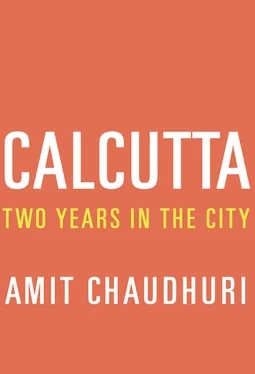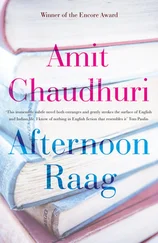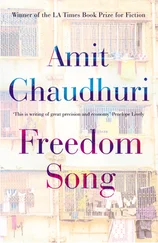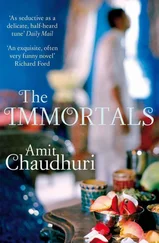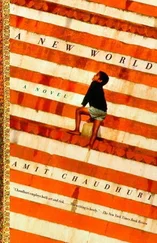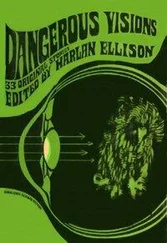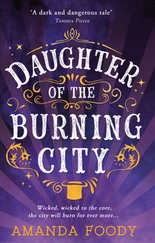Before we landed into the palm and plantain trees and ponds that constitute the outskirts of the city, I ruminated on a final comparison with my new friend. “Where, after all, was Dubai fifty years ago, or for that matter Hong Kong, Delhi, or Bombay? Calcutta was India’s premier city; one of the world’s greatest.” Yet we felt a quickening on viewing the familiar scene from above in the morning light.
Growing up in Bombay, I’d feel a mysterious charge of anticipation on returning to Calcutta. I loved the domestic airport in the sixties — an old colonial building with potted plants, like a hospice. And I loved, too, the way from the airport to Bhowanipore in the south, towards my uncle’s house: the pastoral scene at the start, ponds and palm trees, giving way gradually to city lanes, and then to the narrow and long Pratapaditya Road, where working women in the porches of the small houses wore a single faded piece of cotton as a sari, but no blouse underneath, just as I remembered them from the last visit. Could a city be a village and a city at once? Could it be both what it had become after Job Charnock, supposedly the founder, had first arrived there — the great metropolis of the East — and still retain to itself the shadows of Sutanati and Kolikata and Gobindapur, the three villages from which it had risen? On the way inward from the airport, it certainly seemed so: not only to me, but, I felt, to the Bengalis who lived here — that they were at once in the midst of the modern and the ancestral and fabular.
My child’s excitement had relatively little to do with actually knowing anything about the transformation in the nineteenth century that had made Calcutta what it was when I first discovered it: a perplexing, contemporary thing. The Bengalis had no grand history, in the way the Rajasthanis or Biharis did. “[I]f the sahibs go out to kill a bird, they write a history of it, but the Bengalis have no history,” complained Bankimchandra Chatterjee. “The people of Greenland have a history, the Maori race too has a history … Even the Oriyas have a history,” he concluded, scathingly. Writers don’t so much write about their own lives as create them, Barthes said; it’s an oddly modern idea. Bengalis, similarly, had to make their own history. They did it in houses, tenements, and in neighbourhoods connected by stifling alleys that are no wider than a small room. This making is what I must have had an intuition of, even as a child. And this is why I feel, even now, that the most revealing places in Calcutta are not the museums or the great monuments (of which, anyway, there aren’t many), but the houses and lanes in which people live. “I like this city,” the novelist Akhil Sharma shrugged and admitted to me on his second trip to it. “You feel that something happened here.”
Something did. Under the Crown, Calcutta, capital of the new India, became “second city” of the Empire, till that privilege was rescinded in 1911, and the capital moved to a less political and a quieter place, Delhi, a superannuated historical site, the seat of the thirteenth-century Sultanate, a city that had receded into invisibility since the poet-king Bahadur Shah Zafar’s arrest in 1857 for his role in the Sepoy Mutiny. In doing so, the British appeared to turn away from modern man, everyman, the “little man” of modernity, to what they always preferred in India, even while deriding it: the historical setting, ancient heritage. If that was all there was to it, Calcutta’s significance would be the significance of a major administrative port, and Bengal an episode in colonial history, possibly an evocative locale in a period film, like Siam. But other things had happened. The Asiatic Society, where the Indo-European family of languages was first identified, was founded; institutions came into being, including the great educational ones, the Hindu (later, Presidency) College and Calcutta University, the latter for more than a century India’s most prestigious centre for higher studies. Well before this, Raja Rammohun Roy, the polyglot Bengali scholar, had, by the end of the eighteenth century, made a career change, unexpectedly making the leap, as the historian Christopher Bayly points out, from being a “late-Mughal state intellectual” to being the “first Indian liberal.” If you look at portraits of the man, you see a handsome moustached face under a circular turban, locks of carefully kempt hair on either side, and the figure itself occupying the long robe of the Persian style. The myopic, dhuti-wearing bhadralok — almost always bespectacled, like a Jewish comedian — still hasn’t emerged in Roy’s time or even, later, in Rabindranath’s. Roy’s face, in the portraits, is unique, but also generic, like the faces of Elizabethan England — Shakespeare, Marlowe, Elizabeth I herself — which are reported to derive from a single ur-outline. Roy, himself, is just about to leave that world, no sooner has he entered it; he looks busy, as a corporate man might today. Who is this pretender; what is he up to? Engaged in argument with Brahmin pundits and Christian missionaries alike, his legacy is associated with the religious, social, and intellectual reform that began to transform Bengal by the nineteenth century; but it contains the germ of the most interesting project taken up by this undistinguished lot, the Bengalis: the project of creating themselves. By the 1860s, Bengalis were not only producing the canon — poetry, fiction, criticism — but making their own history.
Naturally, colonial contact engendered some of these possibilities while shutting down others; but what “happened” can’t be comfortably reduced to the notion of Western influence. What’s most intriguing is that the British knew almost nothing of what was “happening” in Calcutta’s cultural life; invisibility was one of Bengali modernity’s prerequisites and cardinal achievements. It conferred invisibility too; if you read Bengali literature, you won’t find out a great deal from it about the British rulers — they generally fell outside the purview of its restively cosmopolitan explorations. Bengali writing, then, was deeply but strategically realist, focusing on certain details, excising others, inventing a world richer than any English-language account of the age. It was immersed in, and excited by, the extraordinariness it was located in; you get the feeling that well before Calcutta was appointed the Indian capital, and well after it had ceased to be one, it was a capital of the nineteenth century and of modernity. Sartre began his essay “La République du silence” with the provocation that the French were probably most free under Nazi occupation. You feel something similar, but on an incomparably larger scale, surveying the curiously munificent and playful texts and artworks that Bengal produced from the 1860s to the 1970s; that political invisibility can sometimes be a necessity for play. Tagore invokes the word chhuti —“holiday”—repeatedly in his songs and poems, in a magical, talismanic way. He writes in his memoirs of staring out of the mullioned veranda of his ancestral house into the garden; his life as a pupil and student is a narrative of one who’s attempting constantly to escape discipline. He can’t bear the presence of the English, and, despite his wariness of Indian nationalism, his life is punctuated by both personal and public rebuttals of the British government. And yet if you look at his restless travelling between genres, his experiments in poetry, fiction, art, and even fashioning a persona, you’re confronted by a Bengali who is, in one sense, confined and invisible, and who is, in another, at his most free.
If you ask a Bengali today about what happened to this inheritance, he or she, in all likelihood, will blame the Left Front government for its unravelling. Until recently, a range of other scapegoats and factors would have been mentioned. Among them would be the British government, which partitioned Bengal twice, the second time upon Independence, destroying its core industries, like jute, and, before that, in 1943, creating a famine. So would the largely Congress-led central government’s puzzlingly stepmotherly economic policies towards West Bengal. (For instance, the infamous “freight equalisation policy” that Nirupam Sen had mentioned.) The Naxal movement, and its subsequent strangulation by the then Congress state government and the police, would be cited as a further reason contributing to Bengal’s present drift.
Читать дальше
